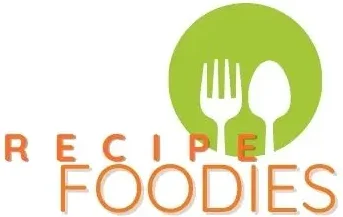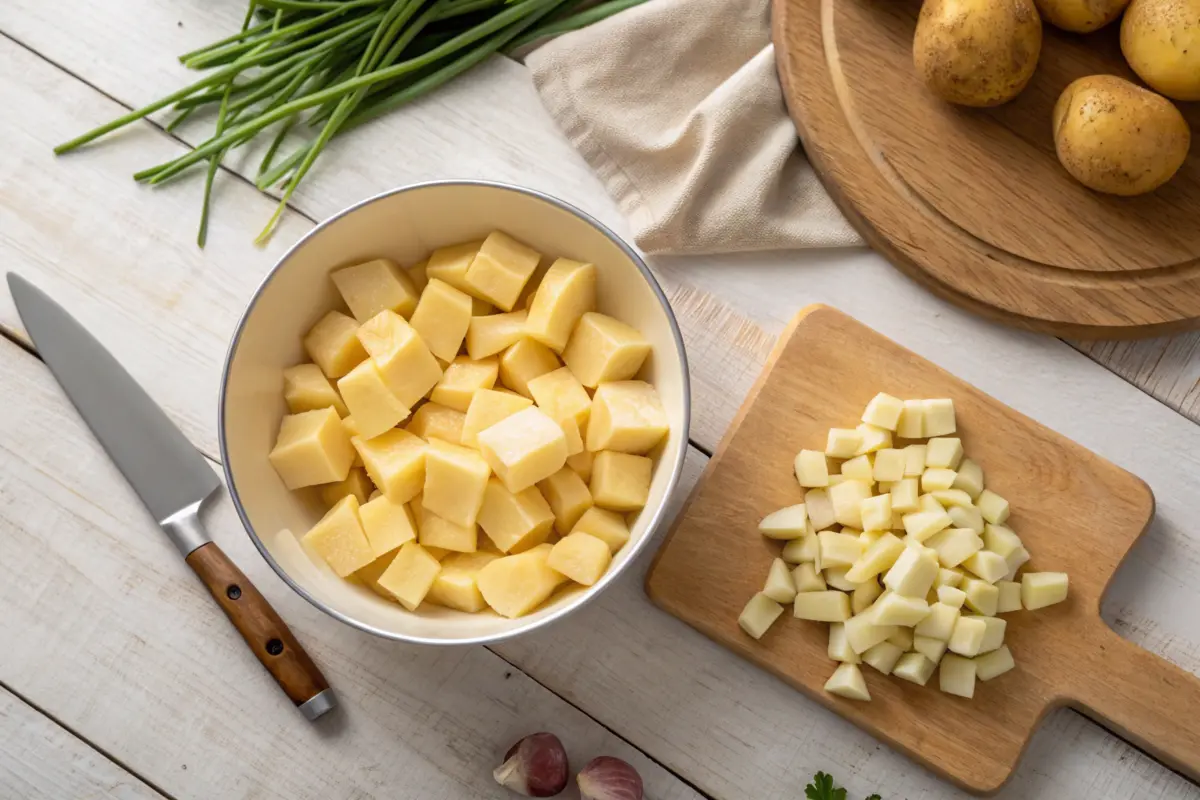Potatoes are a staple ingredient in countless recipes, but when it comes to slow cooking, many cooks find themselves wondering: Do you have to boil potatoes before slow-cooking? This question sparks debates because the way potatoes are prepared can significantly affect the final dish. In this article, we’ll unravel this mystery step by step. You’ll learn whether boiling is necessary, the types of potatoes best suited for slow cooking, and how to prepare them properly. We’ll also explore practical cooking methods, dive into recipes, and answer your most pressing questions. So, grab your apron, and let’s dig into the fascinating world of slow-cooked potatoes!
Understanding the Role of Potatoes in Slow Cooking
Importance of Preparation Methods
Preparation is everything when it comes to slow cooking potatoes. Whether you’re making mashed potatoes, potato soup, or a hearty roast, how you prepare them affects the dish’s texture, flavor, and consistency. Slow cookers rely on moist heat and extended cooking times, which means that the way you treat your potatoes beforehand determines how they’ll hold up.
When deciding whether to boil potatoes before slow-cooking, factors such as their starch content, size, and purpose in the dish come into play. For instance, waxy potatoes tend to hold their shape better, while starchy ones may break down more easily. But does this mean boiling is always the answer? Let’s explore.
Common Questions About Pre-Cooking Potatoes
If you’re asking yourself, “Do I really need to boil potatoes before slow-cooking?”, you’re not alone. Many cooks worry about mushy potatoes, uneven cooking, or undercooked centers. Others wonder whether peeling, cutting, or seasoning them first makes a difference.
Here’s the thing: pre-cooking potatoes has its advantages, but it isn’t always required. Factors like your chosen recipe, desired texture, and the type of potato you’re using play a massive role. Plus, there are tricks—like soaking to reduce starch—that can improve results without boiling.
As we delve deeper into this topic, you’ll discover why preparation matters and how it can elevate your slow-cooking experience. Whether you’re an experienced chef or a home cook looking to perfect your craft, these tips will transform how you prepare potatoes for slow cooking.
Do You Have to Boil Potatoes Before Slow-Cooking?
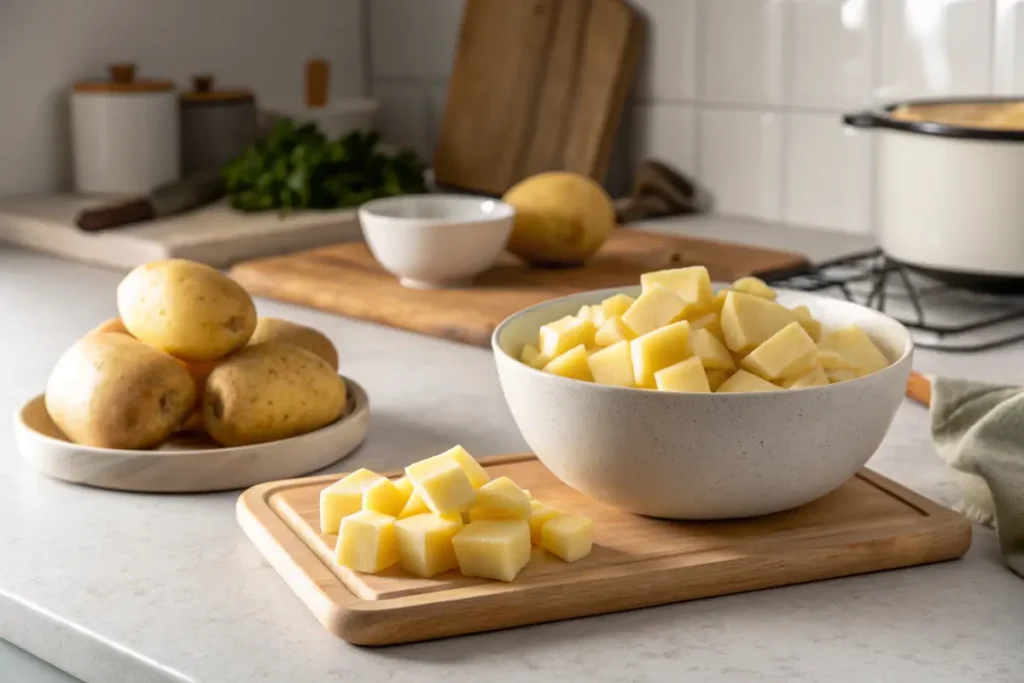
Evaluating the Necessity of Boiling Potatoes
The question of whether you need to boil potatoes before slow-cooking depends largely on your recipe goals. While some dishes benefit from the extra step of pre-cooking, others thrive when potatoes are added raw. Slow cookers rely on prolonged, even heat, which is usually sufficient to cook potatoes thoroughly. However, your decision may hinge on several key factors.
Factors Influencing the Decision
- Type of Potato: The kind of potato you use significantly impacts the outcome. Waxy varieties, like red or Yukon Gold potatoes, maintain their structure better during slow cooking, making boiling less critical. Starchy potatoes, like Russets, tend to break down, so a quick boil can help stabilize them if you want them to hold their shape.
- Desired Texture: If you want your potatoes to remain firm in a stew, boiling can prevent them from becoming overly soft. Conversely, for mashed potatoes or soups, raw potatoes are perfectly fine, as their starchy nature will help thicken the dish.
- Recipe Requirements: The nature of your dish matters too. Creamy soups or chowders often call for potatoes to cook and dissolve slightly, which makes raw additions suitable. For layered casseroles or salads, pre-cooking ensures consistent textures.
How Starch Levels Affect Texture
Potatoes with higher starch levels, such as Russets, tend to absorb more liquid and break down faster during cooking. This is great for creamy dishes but can lead to disintegration in recipes that require distinct potato pieces. On the other hand, waxy potatoes like fingerlings or red potatoes hold their shape due to lower starch content, making them ideal for stews and roasts.
By boiling high-starch potatoes briefly before slow cooking, you reduce their likelihood of over-softening, preserving their integrity. However, waxy potatoes often don’t need this step, as their natural structure withstands the slow cooker’s moist heat without issue.
Impact on Recipe Outcomes
The choice to boil potatoes can also affect how other ingredients in your dish interact. For example, boiling reduces some starch, preventing the cooking liquid from becoming too thick. This may be desirable in broths or soups but less so in casseroles that need starchy binding.
Additionally, boiling potatoes partially cooks them, which speeds up the overall slow-cooking process. This can be handy if you’re short on time, as pre-cooked potatoes won’t need as many hours in the slow cooker. On the flip side, skipping the boiling step allows flavors to meld more deeply into the potatoes during the slow cooking process, enhancing the dish’s overall taste.
Pros and Cons of Boiling Potatoes Before Slow Cooking
Pros:
- Ensures even cooking, particularly for larger potato pieces.
- Helps reduce excess starch for clearer soups or broths.
- Prevents mushiness in high-starch potato varieties.
- Speeds up the cooking process, ideal for time-sensitive recipes.
Cons:
- Adds an extra step to preparation, which may not always be necessary.
- Can lead to overcooking if potatoes spend too long in the slow cooker after boiling.
- May result in reduced flavor absorption, as boiled potatoes absorb less liquid.
- Not needed for waxy potatoes, which already hold their shape.
Ultimately, boiling potatoes before slow cooking is a strategic decision based on the type of potato, your recipe’s goals, and the desired texture. While it’s not mandatory, it can enhance certain dishes and save you from potential pitfalls.
Types of Potatoes and Their Suitability for Slow Cooking
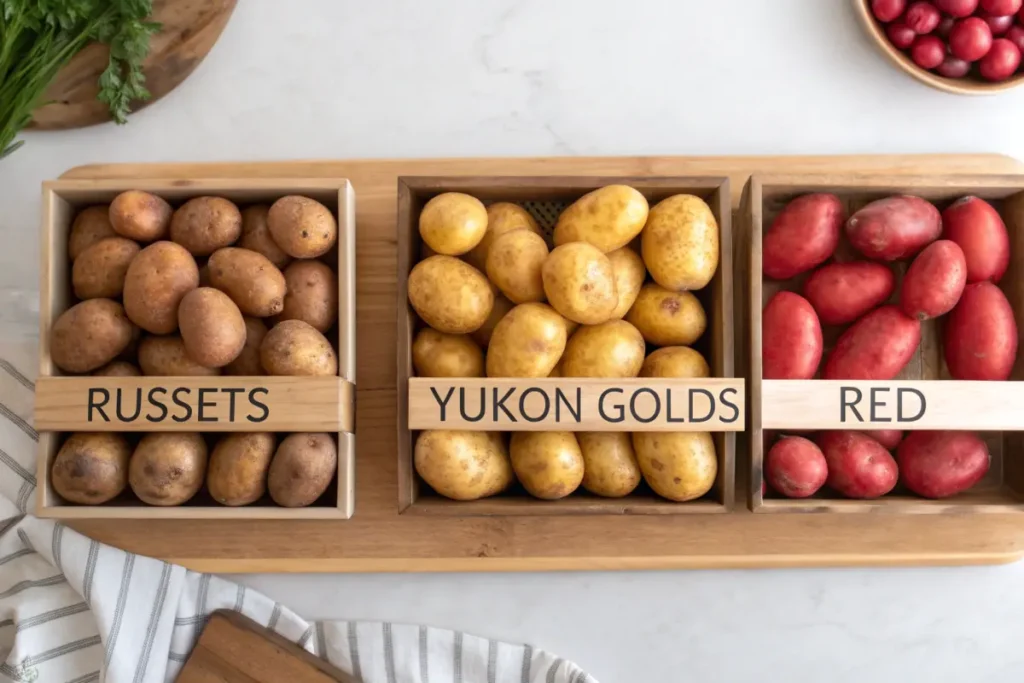
High-Starch Potatoes: Soft and Creamy Results
High-starch potatoes, such as Russets, are the go-to choice for dishes that require a soft, fluffy texture. Their elevated starch content allows them to absorb more liquid during cooking, making them ideal for creamy soups, mashed potatoes, and chowders. However, their delicate structure means they can break down quickly, especially in the long, moist environment of a slow cooker.
When used in recipes like potato soups, the breakdown of high-starch potatoes works to your advantage, as it helps thicken the dish naturally. But for stews or casseroles, where maintaining distinct pieces is crucial, these potatoes may require a brief boil before slow cooking to firm up their texture. Additionally, peeling Russets before cooking is usually recommended, as their skin doesn’t hold up well under extended cooking times.
Waxy Potatoes: Firm and Structured
If you’re looking for potatoes that can hold their shape in slow-cooked dishes, waxy varieties like red potatoes or fingerlings are the perfect match. These potatoes have a lower starch content and a higher moisture level, allowing them to stay intact even after hours of cooking. This makes them an excellent choice for stews, roasts, or layered casseroles where structural integrity is key.
One of the advantages of waxy potatoes is their thin skin, which eliminates the need for peeling in many recipes. Their vibrant appearance adds a touch of visual appeal, especially in rustic or hearty dishes. These potatoes also soak up just enough flavor without losing their natural firmness, making them a versatile choice for recipes that rely on distinct, flavorful components.
All-Purpose Potatoes: Versatility in Every Recipe
All-purpose potatoes, like Yukon Golds, strike a balance between the starchy and waxy categories. They have moderate starch content and a creamy texture, making them suitable for almost any slow-cooked dish. Whether you’re preparing a rich potato soup, a layered gratin, or a comforting roast, these potatoes adapt beautifully to various recipes.
What sets all-purpose potatoes apart is their golden hue and naturally buttery flavor, which enhances the taste of dishes without additional seasoning. They hold their shape reasonably well during slow cooking, though they can also break down slightly in soups or stews, contributing to a creamy consistency.
If you’re unsure which type of potato to use in a recipe, all-purpose varieties are a safe and reliable choice. Their versatility eliminates the need for extra preparation steps like boiling, as they perform well in both raw and pre-cooked applications.
Preparation Techniques for Potatoes in Slow Cooking
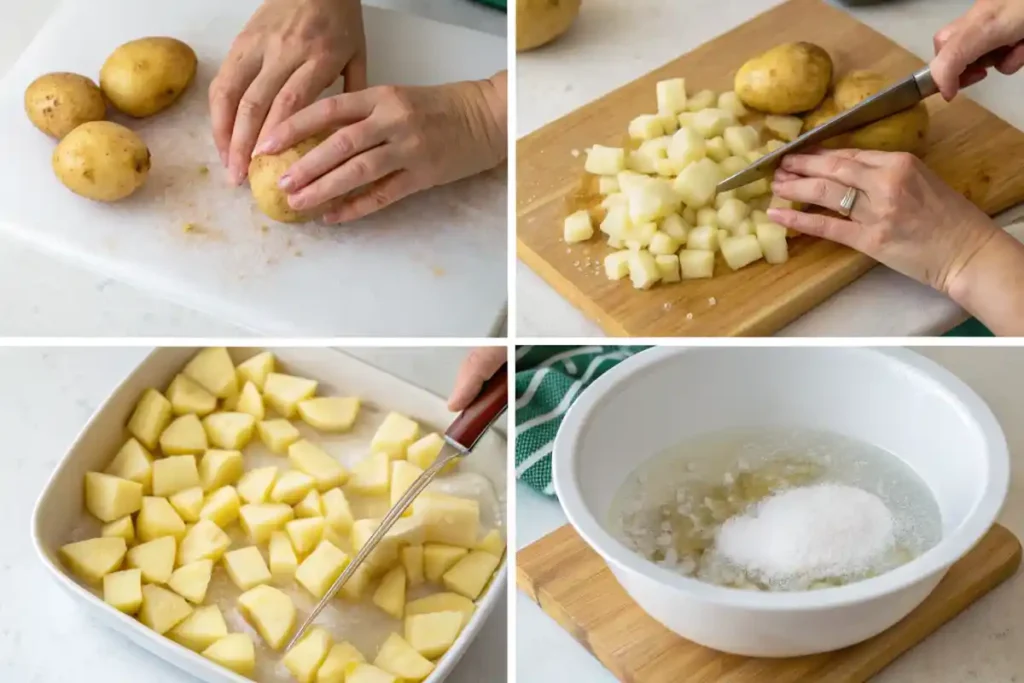
Washing and Peeling Potatoes
Before you do anything else, thoroughly washing your potatoes is crucial. Potatoes are grown in soil, and their skin often carries dirt and debris. Use a vegetable brush under running water to scrub away grime. Even if you’re peeling them, washing is a step you shouldn’t skip—it prevents dirt from transferring to your knife or cutting board.
For recipes that don’t require the skin, peeling comes next. While waxy potatoes with thin skins can often be left unpeeled for a rustic texture, high-starch varieties like Russets should be peeled for a smoother outcome. Use a sharp vegetable peeler and ensure the potatoes are rinsed again after peeling to remove any remaining starch residue.
Cutting Potatoes for Even Cooking
Cutting potatoes into uniform pieces ensures they cook evenly in the slow cooker. Unevenly sized chunks can result in some pieces becoming overcooked and mushy while others remain undercooked. A consistent size—whether diced, cubed, or sliced—also allows flavors to distribute more evenly throughout the dish.
For stews or roasts, aim for bite-sized cubes, roughly 1–2 inches wide. In soups or mashed potato recipes, larger chunks may be used as they’ll soften and break down naturally. A sharp chef’s knife is essential for clean cuts, especially for waxy potatoes, which tend to resist slicing due to their firm structure.
Soaking to Reduce Excess Starch
Soaking potatoes before slow cooking can help reduce their starch content, which benefits recipes requiring clear broths or crisp textures. Starchy potatoes, in particular, release a cloudy residue when cut, and soaking prevents this from affecting the dish’s consistency.
To soak, place the cut pieces into a bowl of cold water and let them sit for at least 30 minutes. For an extra step, rinse the potatoes once more under running water to wash away any remaining starch. However, this technique is less necessary for waxy or all-purpose potatoes, as they naturally contain less starch.
Seasoning Potatoes for Enhanced Flavor
Seasoning your potatoes before slow cooking allows the flavors to penetrate deeply, especially during extended cooking times. A simple blend of salt, pepper, and olive oil works wonders for most recipes, but adding garlic powder, smoked paprika, or dried herbs can elevate the taste further.
If you’re preparing potatoes for a soup or stew, consider seasoning them lightly, as the broth or sauce will infuse them with additional flavor. For roasts or casseroles, toss the potato pieces in your chosen spices and let them sit for a few minutes to absorb the seasoning before adding them to the slow cooker.
These preparation techniques ensure your potatoes are not only ready for slow cooking but also primed to deliver exceptional flavor and texture.
Cooking Methods: Boiling vs. Direct Slow Cooking
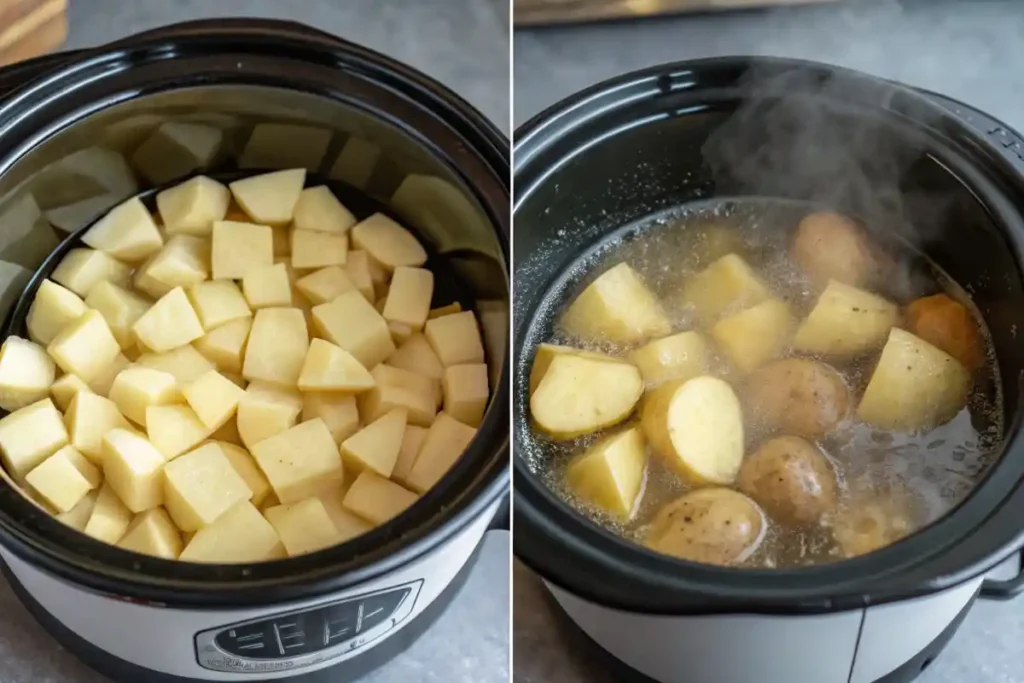
Boiling Potatoes Before Slow Cooking
Boiling potatoes before adding them to a slow cooker offers several advantages, particularly for dishes that demand firm textures. By pre-cooking them, you partially control how much the potatoes soften during the slow-cooking process. This method is especially useful when working with high-starch varieties like Russets, which can become overly mushy if left raw in a slow cooker for hours.
Step-by-Step Guide to Boiling Potatoes:
- Prepare the Potatoes: Wash and peel them if required, then cut into uniform pieces.
- Boil Water: Fill a pot with enough water to cover the potatoes and bring it to a boil. Add a pinch of salt for flavor.
- Cook Potatoes: Add the potatoes to the boiling water and cook for 5–7 minutes until they’re slightly softened but still firm.
- Drain and Cool: Remove the potatoes from the water and let them cool before adding them to the slow cooker.
Boiling allows the potatoes to maintain their structure in dishes like stews or casseroles while reducing excess starch that can cloud the cooking liquid. However, over-boiling can lead to overly soft potatoes, making them prone to breaking apart during slow cooking.
Cooking Raw Potatoes in a Slow Cooker
Adding raw potatoes directly to a slow cooker is a time-saving method that allows the potatoes to absorb the surrounding flavors. This approach is ideal for soups, chowders, or mashed potatoes, where the softening of the potatoes is desirable.
As the slow cooker uses moist heat to cook the potatoes, the long cooking time gradually breaks down the starches, creating a tender, melt-in-your-mouth texture. Waxy potatoes, like red or Yukon Gold, retain their shape well in this method, making them perfect for stews or roasts.
Practical Tips for Cooking Raw Potatoes:
- Cut Evenly: Uniform pieces ensure even cooking and prevent some chunks from becoming undercooked.
- Layer Strategically: Place the potatoes on the bottom of the slow cooker where the heat is strongest.
- Adjust Cooking Time: Potatoes typically take 4–6 hours on low or 2–3 hours on high to become tender.
Cooking raw potatoes allows the natural starches to thicken the dish, making it a one-pot solution without the need for pre-cooking. However, keep in mind that large chunks may take longer to cook through, especially in dense recipes.
Practical Advice: Choosing the Right Method
The decision between boiling and direct slow cooking comes down to your recipe goals:
- Choose Boiling if you need potatoes to stay firm in dishes like casseroles or stews. This is also a great option when you want to remove excess starch for a clearer broth or sauce.
- Opt for Raw Cooking when making soups, mashed potatoes, or recipes where flavor absorption and a softer texture are desired.
By understanding the strengths of each method, you can tailor your approach to achieve perfect potatoes every time.
Recipes and Applications
Slow Cooker Mashed Potatoes
Mashed potatoes in a slow cooker are a game-changer for busy cooks. This method ensures they’re creamy and flavorful without the need for constant attention. Start by peeling and cutting high-starch potatoes, like Russets, into chunks. Place them in the slow cooker with water or broth, garlic, and a pinch of salt. Let them cook on low for 4–6 hours or until tender.
Once cooked, drain the liquid (reserve a little for mashing), and mash the potatoes directly in the slow cooker. Add butter, cream, or milk for richness, and season with salt and pepper. Keep them warm by setting the cooker to “keep warm” mode until ready to serve—perfect for holiday meals or gatherings.
Slow Cooker Potato Soup
Slow cooker potato soup is hearty, comforting, and simple to make. Use Yukon Gold potatoes for their creamy texture, and dice them into small, even cubes. Combine the potatoes with onions, garlic, chicken or vegetable broth, and your choice of seasonings in the slow cooker. Cook on low for 6–8 hours or high for 3–4 hours.
Once tender, use an immersion blender to puree part of the soup, leaving some chunks for texture. Stir in cream, shredded cheese, or crumbled bacon for added richness. Garnish with chives or green onions before serving. This recipe is ideal for chilly evenings or meal prepping for the week.
Slow Cooker Roasted Potatoes
Roasted potatoes in a slow cooker bring crispy flavor without needing an oven. Use waxy potatoes, like red or baby potatoes, and cut them into halves or quarters. Toss the potatoes with olive oil, garlic powder, rosemary, paprika, salt, and pepper.
Place them in the slow cooker and cook on high for 3–4 hours, stirring occasionally to ensure even roasting. For an extra crispy finish, transfer them to a baking sheet and broil for a few minutes before serving. These potatoes are a versatile side dish that pairs perfectly with roasted meats or grilled vegetables.
Slow Cooker Potato Salad
Yes, you can even prepare potato salad in a slow cooker! Choose all-purpose potatoes like Yukon Gold or red potatoes for the best results. Leave the skin on for added texture, and cut the potatoes into bite-sized pieces.
Cook the potatoes with water and a pinch of salt on low for 4–5 hours until tender but not mushy. Once done, drain and cool the potatoes completely. Toss them with a dressing made of mayonnaise, mustard, vinegar, salt, and pepper. Add mix-ins like chopped celery, onions, and boiled eggs for a classic touch.
This method saves time and ensures perfectly cooked potatoes for a refreshing, flavorful salad that’s ideal for picnics or barbecues.
FAQs
Can I Put Raw Potatoes in a Slow Cooker?
Yes, you can add raw potatoes directly to a slow cooker. They will cook thoroughly using the slow, moist heat, but make sure they are evenly cut to ensure consistent cooking.
How Long Do Potatoes Take to Cook in a Slow Cooker?
Potatoes typically take 4–6 hours on low heat or 2–3 hours on high heat. Larger pieces or whole potatoes may require additional time to become tender.
Do I Need to Peel Potatoes Before Slow Cooking?
Peeling is optional and depends on the recipe. Waxy potatoes with thin skins don’t require peeling, while high-starch potatoes, like Russets, are often peeled for smoother results.
Can I Use Any Type of Potato in a Slow Cooker?
Yes, but the type of potato matters. Waxy potatoes hold their shape best, while starchy ones may break down. All-purpose potatoes like Yukon Gold are versatile for most recipes.
How Can I Prevent Potatoes from Becoming Mushy in a Slow Cooker?
Use waxy or all-purpose potatoes, avoid overcooking, and consider boiling starchy potatoes slightly before adding them to the slow cooker.
Is It Necessary to Soak Potatoes Before Slow Cooking?
Soaking can reduce excess starch, which is helpful for clear broths or firmer potatoes. However, it’s not mandatory for all recipes, especially when using waxy potatoes.
